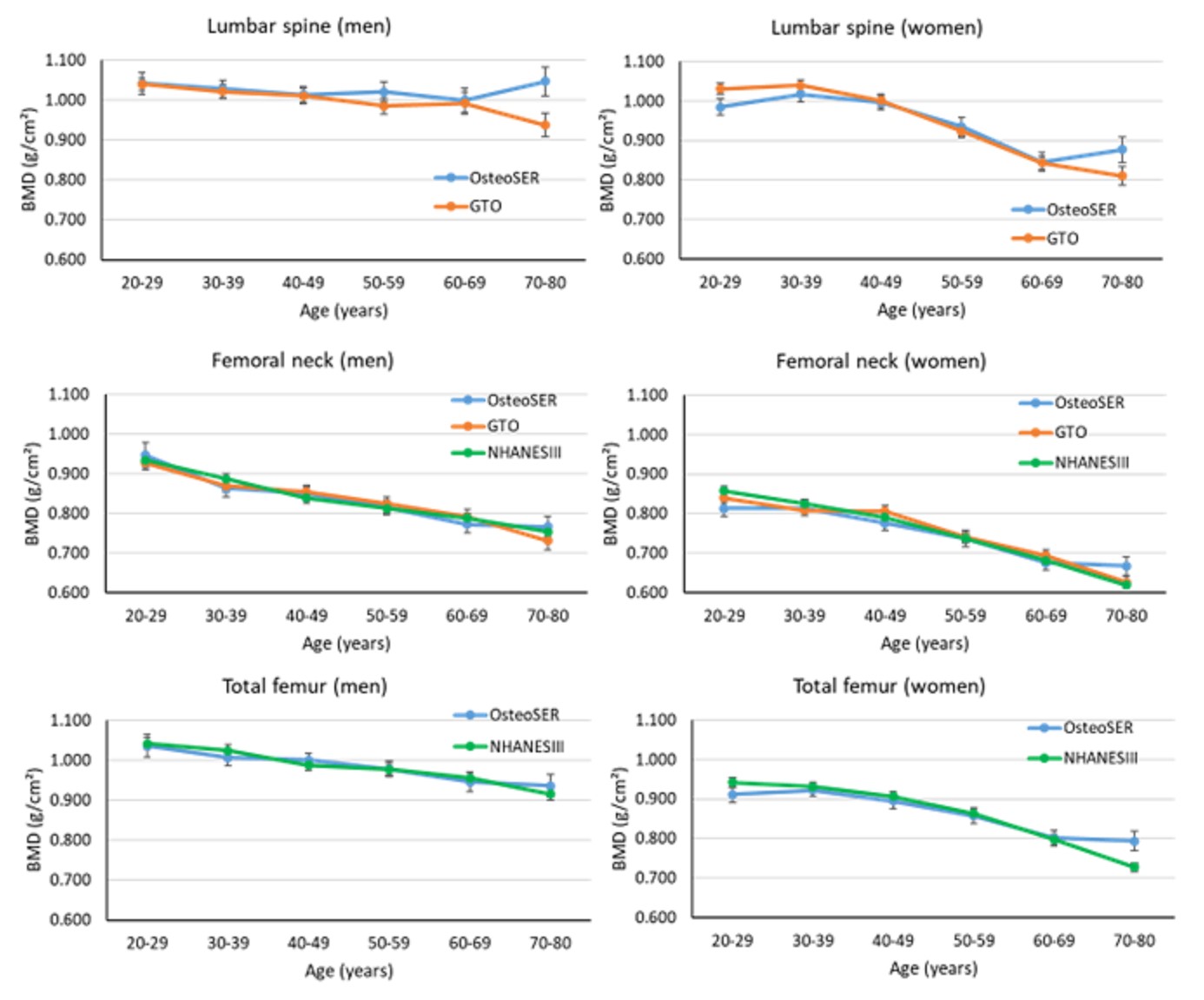Session Information
Date: Monday, November 18, 2024
Title: Osteoporosis & Metabolic Bone Disease – Basic & Clinical Science Poster
Session Type: Poster Session C
Session Time: 10:30AM-12:30PM
Background/Purpose: The bone mineral density (BMD) reference data for the Spanish population comes from the study Multicentre Research Project on Osteoporosis (MPRO), concluded in 1989.
Our aims were to estimate the distribution of BMD in the lumbar spine, femoral neck, and total hip in the Spanish population aged ≥ 20 years and compare it with the MPRO and the NHANES III studies.
Methods: The OsteoSER project is a multicenter cross-sectional observational study conducted in a Caucasian Spanish population aged 20 to 80 years. Fifteen primary care centers from urban and rural municipalities in six provinces (representative of fracture risk in Spain) participated. Each primary care physician consecutively invited patients who met the selection criteria (following a stratification by sex, age and BMI of the Spanish population) and recorded the clinical variables on an electronic case report form. A vehicle with a Hologic® Horizon W densitometer traveled to each municipality. Subjects of all ages with known artifacts in the BMD image and subjects aged 20-39 years with conditions and treatments with deleterious effects on bone were excluded.
We calculated BMD mean and standard deviation by age and sex strata, and the classification in WHO categories [95% CI]. Multiple linear regression was applied to study the potential relationship of peak bone mass with clinical variables. The degree of agreement between the WHO diagnostic classification according to OsteoSER and MPRO was assessed using the Kappa concordance coefficient.
Results: 1522 subject underwent densitometry (51.8% men).
Peak bone mass is reached between 20 and 39 years in both sexes at the tree locations. The multivariate analysis, including sex as a covariate, showed a significant direct relationship with height, BMI, and physical exercise, and an inverse relationship with smoking, for the three locations (p< 0.05).
A decrease in BMD with age is observed at all three locations. BMD values are lower in women than in men (p< 0.001), except for the lumbar spine, where the differences are only observed between the ages of 50 and 80 years (p< 0.001).
The evolution of BMD by age and sex is similar to that of MPRO and NHANES III (Figure 1).
In the group of premenopausal women and men under 50 years, 96.7% [95.4-97.9] of the subjects had BMD values within the expected range for their age. In the group of postmenopausal women and men aged 50 or older, 54.4% [50.7-58.1] of the subjects had osteopenia and 10.7% [8.4-13.0], osteoporosis. The prevalence of osteoporosis was higher in women (18.6% [14.5-22.6]) than in men (2.6% [0.9-4.2]) and significantly increased with age: in women, it rises from 11.3% in the 50-59 age group to 25.8% in the 70-80 age group.
The Kappa concordance coefficient between the WHO diagnostic classification according to OsteoSER and MPRO was 0.818 (p< 0.001). The prevalence of osteoporosis rises to 14.6% [12.6-17.5] when calculated according to MPRO.
Conclusion: The BMD of the OsteoSER study population was similar to those of MPRO and NHANES III. Peak bone mass has a direct relationship with physical exercise, and an inverse relationship with smoking. A higher proportion of osteoporosis is diagnosed when calculated with MPRO compared to OsteoSER.
To cite this abstract in AMA style:
Gomez Vaquero C, Domínguez-Álvaro M, Seoane-Mato D, Peris P, Castañeda S, Kanterewicz Binstock E, Mazzucchelli R, Arboleya L, Bernad M, Alvarez-Cienfuegos A, Correa B, Jimenez-Liñan L, Mateo-Pascual C, Molina del Rio M, Retamal-Ortiz M, Lopez-Laguna A, Molera-Valero R, Alvar-Pariente S, Pascual A, Arias-Senso A, Perez-Gutierrez N, Garcia-Frias S, Bouza-Alvarez D, Sostres S, Suarez-Hernandez D, Zamora-Casal A, Garcia-Ramirez C, González-Dávila E. Analysis of the Evolution of Bone Mineral Density in the Spanish Population: Results of the OsteoSER Study [abstract]. Arthritis Rheumatol. 2024; 76 (suppl 9). https://acrabstracts.org/abstract/analysis-of-the-evolution-of-bone-mineral-density-in-the-spanish-population-results-of-the-osteoser-study/. Accessed .« Back to ACR Convergence 2024
ACR Meeting Abstracts - https://acrabstracts.org/abstract/analysis-of-the-evolution-of-bone-mineral-density-in-the-spanish-population-results-of-the-osteoser-study/

